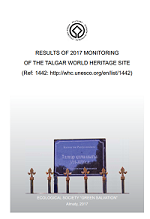The Bulletin of Green Salvation has been published since 1995. It is an ongoing publication, issued 2-3 times per year with a supplement (in Russian and English). The Bulletin is registered by the National Agency for the Press and Mass Media of the Republic of Kazakhstan.
The bulletin is organized by topic. Individual issues have been devoted to urgent problems of environmental education, improvement of nature conservation legislation, the functioning of specially protected natural territories, and other social and ecological problems. Within the pages of the Bulletin can be found materials by Kazakhstani and foreign experts, scientists, and representatives of public organizations. Although the editors prefer analytical materials, significant space is given to articles concerning urgent problems. Articles written by the employees of Green Salvation are based on the results of the organization’s concrete activities.
The Bulletin of Green Salvation is distributed free of charge (in printed and electronic form) among non-governmental organizations, official bodies, activists in the environmental movement, teachers, and environmental experts. It is known both within the republic and beyond its borders (in Central Asia, Russia and other countries of the CIS, and other foreign countries).
The reprinting of materials is welcomed, provided that the Bulletin is cited and the author of the material indicated.
You can subscribe to the Bulletin of Green Salvation in either form via the following address:
050000, Republic of Kazakhstan, Almaty,
st. Shagabutdinova 58, apt. 28
E-mail: <gsalmaty@gmail.com>
Telephone: +7 (727) 253-62-56, +7 (727) 234-17-60.
Please specify in your application the form (printed or electronic) in which you would like to receive the Bulletin.
Green Salvation also has other print publications, with which you can become acquainted in this section of the site.
The organization’s most recent original materials published in other mass media can be found in the following section.
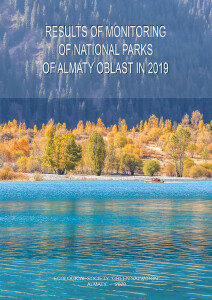 Results of monitoring of national parks of Almaty oblast in 2019 (pdf, 9 Mb)
Results of monitoring of national parks of Almaty oblast in 2019 (pdf, 9 Mb)
This material is a continuation of the publications “Results of monitoring of national parks of Almaty oblast in 2017” and “Results of monitoring of national parks of Almaty oblast in 2018.” The main focus is on the situation in Ile-Alatau State National Natural Park (hereinafter – Ile-Alatau SNNP). The park has invaluable importance for preserving biological diversity of the region, being essential for health and well-being of residents of the Almaty agglomeration. The report also partially covers the situation in the Charyn State National Natural Park and the “Kolsai Lakes” State National Natural Park.
 Results of monitoring of national parks of Almaty oblast in 2018 (pdf, 7 Mb)
Results of monitoring of national parks of Almaty oblast in 2018 (pdf, 7 Mb)
One of the areas of work of the Ecological Society “Green Salvation” is to promote preservation of ecological systems of national parks of the Almaty region. In order to assess whether the maintenance and use of resources corresponds to the public interests and national parks’ objectives, the organization conducts monitoring.
The collected information allows the Ecological Society “Green Salvation” to take practical actions that are necessary for conservation of specially protected natural territories. The organization files inquiries for environmental information, demands implementation of certain measures, and follows up with the results of actions of authorized bodies on the organization’s statements. In cases of severe violations of the law, the Ecological Society “Green Salvation” contacts prosecution authorities and courts. And finally, if problems cannot be solved at the national level, the organization submits information to the bodies of international environmental conventions ratified by the Republic of Kazakhstan.
“Results of monitoring of national parks of Almaty oblast in 2018” is a continuation of the publication titled “Results of monitoring of national parks of Almaty oblast in 2017.”
 Results of 2018 monitoring of the Talgar World Heritage Site (pdf, 4,4 Mb)
Results of 2018 monitoring of the Talgar World Heritage Site (pdf, 4,4 Mb)
In 2014, Talgar site of ancient settlement was included in the World Heritage List as a part of the joint nomination from China, Kazakhstan, and Kyrgystan: Silk Roads: the Routes Network of Chang’an-Tianshan Corridor. Talgar site is one of the eight Kazakhstan sites included in this nomination. It is located 25 km east of the city of Almaty, near the Almaty nature reserve, in the protection zone of the Ile-Alatau National Park. The Ecological Society “Green Salvation” monitors the condition of the Talgar site since 2015.
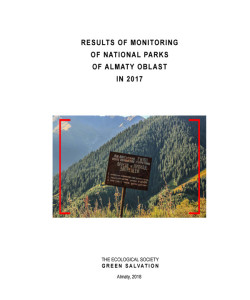 RESULTS OF MONITORING OF NATIONAL PARKS OF ALMATY OBLAST IN 2017 (pdf, 57 Mb)
RESULTS OF MONITORING OF NATIONAL PARKS OF ALMATY OBLAST IN 2017 (pdf, 57 Mb)
In order to assess the extent to which the maintenance of national parks located in the Almaty oblast and the use of their resources comply with the public interest, the Ecological Society “Green Salvation” (hereinafter – ES) performs monitoring. The main objective of the monitoring is to collect information on compliance with the environmental regulations on specially protected natural territories (hereinafter – SPNT). The main focus of the ES is on the territory of the Ile-Alatau National Nature Park (hereinafter – Ile-Alatau SNNP), which is invaluable for the safe existence of the Almaty agglomeration.
Results of 2017 Monitoring of the Talgar World Heritage Site (pdf, 10,5 Mb)
Experts from the World Heritage Committee and International Council on Monuments and Sites (ICOMOS), who visited Kazakhstan from October 31 to November 9, 2016, recommended that the authorized bodies “significantly improve the ecological and archaeological monitoring systems, with active involvement of public organizations and local communities”.1 Fully sharing the opinion of the experts, the Ecological Society “Green Salvation” continues monitoring the Talgar site, one of the eight Kazakhstani monuments on the Silk Road (Silk Roads: the Routes Network of Chang’an-Tianshan Corridor).
 Since 2005, the Ecological Society Green Salvation has been publishing materials on implementation and application of the Aarhus Convention in the Republic of Kazakhstan. On the pages of the Herald, issued on the occasion of the Sixth Meeting of the Parties of the Convention, which covers the period from 2014 to early 2017, the reader will find analytical materials, criticism, opinions.
Since 2005, the Ecological Society Green Salvation has been publishing materials on implementation and application of the Aarhus Convention in the Republic of Kazakhstan. On the pages of the Herald, issued on the occasion of the Sixth Meeting of the Parties of the Convention, which covers the period from 2014 to early 2017, the reader will find analytical materials, criticism, opinions.
Download pdf file: Green Salvation Herald 2017 (pdf, 976 Kb)
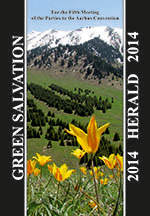 “Green Salvation Herald 2014. For the Fifth Meeting of the Parties to the Aarhus Convention” has been published in English. The new issue of the Herald includes materials on compliance with the Aarhus Convention by the Republic of Kazakhstan.
“Green Salvation Herald 2014. For the Fifth Meeting of the Parties to the Aarhus Convention” has been published in English. The new issue of the Herald includes materials on compliance with the Aarhus Convention by the Republic of Kazakhstan.
Download pdf file: Green Salvation Herald 2014 (pdf, 2.3 Mb)
 Green Salvation Herald 2011 includes materials on compliance with the Aarhus Convention by the Republic of Kazakhstan.
Green Salvation Herald 2011 includes materials on compliance with the Aarhus Convention by the Republic of Kazakhstan.
Download pdf file: Green Salvation Herald 2011 (pdf, 1.3 Mb)
This publication reflects the environmental situation in the Republic of Kazakhstan and the country’s implementation of the decision of the Second Meeting of the Parties to the Convention on Access to Information, Public Participation in Decision-making and Access to Justice in Environmental Matters (Aarhus Convention). The publication is timed for the Third Meeting of the Parties to the Convention (Riga, Latvia, June 11-13, 2008). The Republic of Kazakhstan has approached this event with far from comforting results.
Download pdf file: For the Third Meeting of the Parties to the Aarhus Convention (644 KB)
 The 2006 Green Salvation Herald is now available in English. The latest issue contains information regarding the Republic of Kazakhstan’s compliance with the Aarhus Convention, and the influence of transnational corporations and international financial institutions on the development of the country’s environmental situation. All of the articles are original works written by colleagues and friends of Green Salvation.
The 2006 Green Salvation Herald is now available in English. The latest issue contains information regarding the Republic of Kazakhstan’s compliance with the Aarhus Convention, and the influence of transnational corporations and international financial institutions on the development of the country’s environmental situation. All of the articles are original works written by colleagues and friends of Green Salvation.
Download pdf file: Herald 2006 (1,21 Мb)
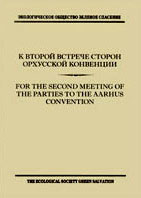 “For the Second Meeting of the Parties to the Aarhus Convention” is a supplement to the issue of the Green Salvation Bulletin timed to coincide with the Second Meeting of the Parties to the Aarhus Convention in Almaty, May 25-27, 2005. The materials in this publication are a continuation of the topic raised in the 17th issue of the Green Salvation Bulletin on “Environmental and Human Rights”. It includes materials we expect to be of interest to those who defend the human rights to a healthy environment, and access to information, decision-making processes and justice. Specifically, this publication includes commentary on the national report on implementing the Aarhus Convention, examples from our experience filing lawsuits in the Republic of Kazakhstan, and materials about lawsuit complaints. The publication is available in Russian and English.
“For the Second Meeting of the Parties to the Aarhus Convention” is a supplement to the issue of the Green Salvation Bulletin timed to coincide with the Second Meeting of the Parties to the Aarhus Convention in Almaty, May 25-27, 2005. The materials in this publication are a continuation of the topic raised in the 17th issue of the Green Salvation Bulletin on “Environmental and Human Rights”. It includes materials we expect to be of interest to those who defend the human rights to a healthy environment, and access to information, decision-making processes and justice. Specifically, this publication includes commentary on the national report on implementing the Aarhus Convention, examples from our experience filing lawsuits in the Republic of Kazakhstan, and materials about lawsuit complaints. The publication is available in Russian and English.
Download pdf file: For the Second Meeting of the Parties to the Aarhus Convention (824 Kb)
 The materials found in the Herald 2003-2004 cover the range of Green Salvation’s activities over the course of 2003-2004: expert analyses, official letters and appeals, and the text of two award-winning documentary films. All of these activities are devoted to accomplishing the organization’s primary mission: defending the right of Kazakhstan’s citizens to a healthy environment, working with state bodies and non-governmental organizations to improve the environmental situation in the Republic of Kazakhstan and beyond, and spreading environmental awareness and appreciation among people of all ages.
The materials found in the Herald 2003-2004 cover the range of Green Salvation’s activities over the course of 2003-2004: expert analyses, official letters and appeals, and the text of two award-winning documentary films. All of these activities are devoted to accomplishing the organization’s primary mission: defending the right of Kazakhstan’s citizens to a healthy environment, working with state bodies and non-governmental organizations to improve the environmental situation in the Republic of Kazakhstan and beyond, and spreading environmental awareness and appreciation among people of all ages.
Download pdf file: Herald 2003-2004 (312 Kb)
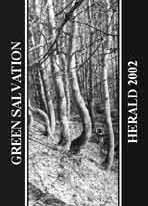 The Green Salvation Herald 2002 contains materials covering the range of Green Salvation’s activities over the past year-expert analyses, civil actions and campaigns, and even the text of a documentary film. All of these activities are devoted to the organization’s primary mission: defending the right of Kazakhstan’s citizens to a healthy environment, working with state bodies and non-governmental organizations to improve the environmental situation in the Republic of Kazakhstan and beyond, and spreading environmental awareness and appreciation among people of all ages.
The Green Salvation Herald 2002 contains materials covering the range of Green Salvation’s activities over the past year-expert analyses, civil actions and campaigns, and even the text of a documentary film. All of these activities are devoted to the organization’s primary mission: defending the right of Kazakhstan’s citizens to a healthy environment, working with state bodies and non-governmental organizations to improve the environmental situation in the Republic of Kazakhstan and beyond, and spreading environmental awareness and appreciation among people of all ages.
The three main themes touched on in the Herald 2002 are the creation of the National Fund of the Republic of Kazakhstan and its implications; the impact of political and economic developments on environmental human rights; and the concerns raised by a proposal by the state nuclear energy company, Kazatomprom, that radioactive waste from other nations be imported and buried in Kazakhstan.
Download pdf file: Herald 2002 (429 Kb)
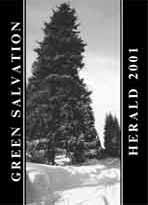 The Herald 2001 is devoted to describing Kazakhstan’s most urgent environmental problems, as well as presenting suggestions for their resolution. Within the pages of the Herald, readers will find active discussion of a wide range of issues, from the hunting of endangered species to the role of transnational corporations, the importing of nuclear waste, and the fate of Kazakhstan’s potential World Heritage Sites. Special attention is devoted to questions of environmental law and international agreements such as the Aarhus Convention and the World Heritage Convention – in other words, the extent to which Kazakhstan’s authorities observe their own rules and obligations.
The Herald 2001 is devoted to describing Kazakhstan’s most urgent environmental problems, as well as presenting suggestions for their resolution. Within the pages of the Herald, readers will find active discussion of a wide range of issues, from the hunting of endangered species to the role of transnational corporations, the importing of nuclear waste, and the fate of Kazakhstan’s potential World Heritage Sites. Special attention is devoted to questions of environmental law and international agreements such as the Aarhus Convention and the World Heritage Convention – in other words, the extent to which Kazakhstan’s authorities observe their own rules and obligations.
Download pdf file: Herald 2001 (438 Kb)
Like the Bulletin of Green Salvation, the Green Salvation Herald 2000 provides analysis and consideration of environmental problems in Kazakhstan. The publication’s aim is not to provide a scientific explanation of these environmental problems, but rather, to look at their underlying, structural causes and provide some possible solutions for their resolution. All of the articles published in this issue of the “Herald” consider the existing environmental law in place (or the lack thereof) to deal with specific environmental problems and make recommendations on policy improvement, either at the micro or macro level.
While the Herald touches on a wide range of environmental problems and issues (from dealing with municipal waste to establishing a national park in the Ile Alatau mountain range) the over-riding message is clear: without the development of basic environmental policy in Kazakhstan, attempting to solve these environmental problems will amount to nothing more than ineffective, stop-gap measures.
Download pdf file: Herald 2000 (246 Kb)
The book before you examines the development of environmental law in Kazakhstan from the country’s declaration of independence in 1991, through the fall of 1997.
The book’s prospective is unique: it provides the only existing comprehensive historic analysis of contemporary processes of development of environmental law in Kazakhstan. It is not, however, a formal legal critique of the environmental legislation in Kazakhstan. Rather it is an attempt to shed light on what environmental law and current legal institutions and processes mean for Kazakhstani NGOs and citizens.
Download pdf file: Reform of Ecological Legislation in Kazakhstan (277 Kb)
Subscribe to our updates





